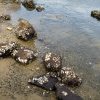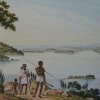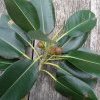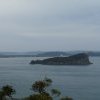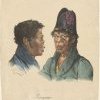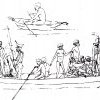1810s
1810
1813
1814
Macquarie notes that “some idle and ill disposed Europeans had taken liberties with (Aboriginal) women, and had also treacherously attacked and killed a woman and her two children whilst sleeping, and this unprovoked cruelty produced retaliation whereby persons perfectly innocent of the crime lost their lives”. (Historical Records of Australia vol 8, pp. 250-251)
1815
The Sydney Gazette on 4 February reports that “on this occasion, sixteen of the natives, with wives and families, were assembled, and his Excellency the Governor, in consideration of the general wish expressed by them, appointed Boogaree (who had been long known as one of the most friendly of this race, and well acquainted with our language), to be their chief, at the same time presenting him with a badge distinguishing his quality as ‘Chief of the Broken Bay Tribe’”. (Sydney Gazette, 4 February 1815)
Governor Macquarie sets up the Native Institution at Parramatta, It is a dormitory school where Aboriginal children can be educated in English ways without the influence of their families and clans. At first some parents leave their children at the school voluntarily, later they realise that they will not be allowed to leave.
Governor Macquarie makes a special effort to encourage Koories to settle and grow crops to compensate for their disappearing traditional food sources.
Macquarie also makes a grant of land to Bungaree and his extended family on Georges Head near Mosman later known as ‘Bungaree’s Farm’. Fields and huts are established but the land is not very fertile. However, many apricots and peach trees flourish and are sold by Bungaree to keep his family. Fishing is good in the harbour and Bungaree makes good use of a rowing boat given to him by Macquarie to row out to sea and catch fish.
When a ship appeared off the Heads, Bungaree, Cora Goseberry or Matora, or other members of his extended family, often row out to meet it. Matora asks the captain for a tot of rum while Bungaree, dressed in his naval uniform points to his farm and the land northwards, and proclaims,
Biddy Lewis later to settle at Marramarra Creek on Broken Bay, also lives from time to time at Bungaree’s Georges Head farm.
1816
Koori people attack farms around Sydney. Macquarie sends Captain Wallis with three detachments of soldiers to arrest offenders. They attack a camp at night and 14 Aboriginal people are killed. Macquarie sets out regulations controlling Aboriginal people. No one is to appear within a mile of any settlement and no more than six are to ‘lurk’ or ‘loiter’ near farms. Passports or certificates are issued to Aboriginals “who conduct themselves in a suitable manner”.
Five more areas are set out as agriculture reserves for Aboriginal people. These people are to receive seed, tools, stores and clothes and are given convicts for six months to help with cultivation.
Macquarie issues two further proclamations outlawing the ten “most violent and atrocious natives”. He orders that those who have not already been killed should be invited to a “General Friendly Meeting” and Blanket Distribution at Parramatta on 28 December.
1817
Captain Phillip Parker King, directed to complete the maritime survey begun by Flinders, recruits Bungaree to go to sea on the Mermaid to chart the coastline to the south and west of Australia. King described Bungaree as “forty five years of age, of sharp, intelligent and unassuming disposition”. As he did with Flinders, Bungaree plays an important part in his interaction with other Aboriginal people and by spearing fish for the crew to eat.
1818
On Bungaree’s return from the voyage, Alexander Berry cares for Bungaree when beaten up by a drunken man, and writes “I found him a man decidedly of considerable natural talent, faithful and trust worthy”. On his return Bungaree finds that his family group has left ‘Bungaree’s farm’ at Georges Head for the Northern Beaches. In this way they continue their long tradition of moving about their country according to food availability, changing seasons, and for meetings and ceremonies.













